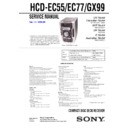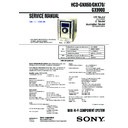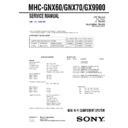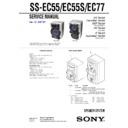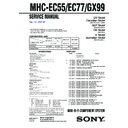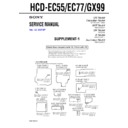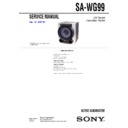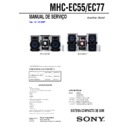Sony HCD-EC55 / HCD-EC77 / HCD-GX99 / MHC-EC55 / MHC-EC77 / MHC-GX99 Service Manual ▷ View online
2
HCD-EC55/EC77/GX99
SAFETY-RELATED COMPONENT WARNING!!
COMPONENTS IDENTIFIED BY MARK
0
OR DOTTED LINE
WITH MARK
0
ON THE SCHEMATIC DIAGRAMS AND IN
THE PARTS LIST ARE CRITICAL TO SAFE OPERATION.
REPLACE THESE COMPONENTS WITH SONY PARTS WHOSE
PART NUMBERS APPEAR AS SHOWN IN THIS MANUAL OR
IN SUPPLEMENTS PUBLISHED BY SONY.
REPLACE THESE COMPONENTS WITH SONY PARTS WHOSE
PART NUMBERS APPEAR AS SHOWN IN THIS MANUAL OR
IN SUPPLEMENTS PUBLISHED BY SONY.
ATTENTION AU COMPOSANT AYANT RAPPORT
À LA SÉCURITÉ!
LES COMPOSANTS IDENTIFIÉS PAR UNE MARQUE
0
SUR
LES DIAGRAMMES SCHÉMATIQUES ET LA LISTE DES
PIÈCES SONT CRITIQUES POUR LA SÉCURITÉ DE
FONCTIONNEMENT. NE REMPLACER CES COM- POSANTS
QUE PAR DES PIÈCES SONY DONT LES NUMÉROS SONT
DONNÉS DANS CE MANUEL OU DANS LES SUPPLÉMENTS
PUBLIÉS PAR SONY.
PIÈCES SONT CRITIQUES POUR LA SÉCURITÉ DE
FONCTIONNEMENT. NE REMPLACER CES COM- POSANTS
QUE PAR DES PIÈCES SONY DONT LES NUMÉROS SONT
DONNÉS DANS CE MANUEL OU DANS LES SUPPLÉMENTS
PUBLIÉS PAR SONY.
MODEL IDENTIFICATION
– Back Panel –
– Back Panel –
•
Abbreviation
AR
AR
: Argentine model
AUS : Australian model
CND : Canadian model
E2
CND : Canadian model
E2
: 120 V AC area in E model
E3
: 240 V AC area in E model
E51 : Chilean and Peruvian models
KR
KR
: Korean model
MX : Mexican model
RU
RU
: Russian model
SP
: Singapore model
Parts No.
Ver. 1.2
General
Power requirements:
Argentine model: AC 220 V, 50/60 Hz
Korean model: AC 220 V, 60 Hz
Korean model: AC 220 V, 60 Hz
Australian model: AC 230 – 240 V, 50/60 Hz
North American model: AC 120 V, 60 Hz
European and Russian models: AC 230 V, 50/60 Hz
European and Russian models: AC 230 V, 50/60 Hz
Mexican model: AC 127 V, 60 Hz
Other models: AC 120, 220 or 230 – 240 V, 50/60 Hz, adjustable with voltage
selector
selector
Power consumption:
HCD-GX99
USA model: 190 W
Canadian model: 245 VA
Canadian model: 245 VA
HCD-EC77
USA model: 190 W
Canadian model: 245 VA
European and Russian models: 140 W
Canadian model: 245 VA
European and Russian models: 140 W
0.5 W (in Power Saving Mode)
Other models: 150 W
HCD-EC55
USA model: 95 W
Canadian model: 130 VA
European and Russian models: 95 W
Canadian model: 130 VA
European and Russian models: 95 W
0.5 W (in Power Saving Mode)
Other models: 95 W
Mass (excl. speakers):
HCD-GX99
North American model: Approx. 6.1 kg
HCD-EC77
North American and European models: Approx. 6.1 kg
Other models: Approx. 6.4 kg
Other models: Approx. 6.4 kg
HCD-EC55
North American model: Approx. 5.0 kg
Other models: Approx. 5.3 kg
Other models: Approx. 5.3 kg
Design and specifications are subject to change without notice.
Dimensions (w/h/d) (excl. speakers):
Approx. 200
×
306
×
410 mm
AM tuner section:
Tuning range
530 – 1,710 kHz (with 10 kHz tuning interval)
531 – 1,710 kHz (with 9 kHz tuning interval)
European and Russian models:
531 – 1,602 kHz (with 9 kHz tuning interval)
Other models:
530 – 1,610 kHz (with 10 kHz tuning interval)
531 – 1,602 kHz (with 9 kHz tuning interval)
Intermediate frequency: 450 kHz
531 – 1,710 kHz (with 9 kHz tuning interval)
European and Russian models:
531 – 1,602 kHz (with 9 kHz tuning interval)
Other models:
530 – 1,610 kHz (with 10 kHz tuning interval)
531 – 1,602 kHz (with 9 kHz tuning interval)
Intermediate frequency: 450 kHz
Pan-American and Australian models:
Model
Part No.
GX99: CND model
2-319-061-0
[]
EC55: CND model
2-893-578-0
[]
EC55: AEP, UK model
2-893-579-0
[]
EC55: RU model
2-893-580-0
[]
EC55: E2 model
2-893-581-0
[]
EC55: E51 model
2-893-582-0
[]
EC55: MX model
2-893-583-0
[]
EC55: AR model
2-893-584-0
[]
EC55: SP model
2-893-586-0
[]
EC55: AUS model
2-893-587-0
[]
EC55: KR model
2-893-588-0
[]
EC77: CND model
2-893-595-0
[]
EC77: RU model
2-893-597-0
[]
EC77: E2 model
2-893-598-0
[]
EC77: E51 model
2-893-599-0
[]
EC77: MX model
2-893-600-0
[]
EC77: AR model
2-893-601-0
[]
EC77: AUS model
2-893-604-0
[]
EC55: US model
3-095-136-0
[]
EC77: AEP model
3-095-137-0
[]
EC77: E3 model
3-095-138-0
[]
GX99: US model
3-095-139-0
[]
EC77: US model
3-095-495-0
[]
3
HCD-EC55/EC77/GX99
TABLE OF CONTENTS
1.
SERVICING NOTES
................................................
4
2.
GENERAL
...................................................................
6
3.
DISASSEMBLY
3-1.
Disassembly Flow ...........................................................
8
3-2.
Side Panel (R), Side Panel (L) .........................................
9
3-3.
Top Panel Assy (Except US, CND) ................................. 10
3-4.
Top Panel (US, CND) ...................................................... 10
3-5.
Front Panel Assy .............................................................. 11
3-6.
Mechanical Deck (Except US, CND) .............................. 12
3-7.
Belt (MAIN), Belt (R/F) (Except US, CND) .................. 12
3-8.
KEY-LEFT Board ............................................................ 13
3-9.
KEY-RIGHT Board, KEY-CD Board, PANEL Board .... 13
3-10. JACK Board ..................................................................... 14
3-11. MAIN Board .................................................................... 15
3-12. CD Mechanical ................................................................ 16
3-13. Optical Pick-up (KSM-213DCP), BD90 Board .............. 17
3-14. Belt (DLM3A) ................................................................. 18
3-15. Chassis ............................................................................. 18
3-16. PT Board (Except EC55:US, CND),
3-11. MAIN Board .................................................................... 15
3-12. CD Mechanical ................................................................ 16
3-13. Optical Pick-up (KSM-213DCP), BD90 Board .............. 17
3-14. Belt (DLM3A) ................................................................. 18
3-15. Chassis ............................................................................. 18
3-16. PT Board (Except EC55:US, CND),
PT (U) Board (EC55:US, CND), Power Transformer ..... 19
3-17. LOW-AMP Board, HI-AMP Board (EC77/GX99) ......... 19
3-18. HI-AMP Board (EC55) ................................................... 20
3-19. DC Fan ............................................................................ 20
3-18. HI-AMP Board (EC55) ................................................... 20
3-19. DC Fan ............................................................................ 20
4.
TEST MODE
............................................................... 21
5.
MECHANICAL ADJUSTMENTS
......................... 25
6.
ELECTRICAL ADJUSTMENTS
.......................... 25
7.
DIAGRAMS
7-1.
Block Diagram — BD/DRIVER Section — .................. 30
7-2.
Block Diagram — TUNER Section — .......................... 31
7-3.
Block Diagram — MAIN Section — ............................. 32
7-4.
Printed Wiring Board — BD90 Board — ...................... 33
7-5.
Schematic Diagram — BD90 Board — ......................... 34
7-6.
Printed Wiring Boards — MAIN Section — ................. 35
7-7.
Schematic Diagram — MAIN Section (1/2) — ............. 36
7-8.
Schematic Diagram — MAIN Section (2/2) — ............. 37
7-9.
Printed Wiring Board — PANEL Board — ................... 38
7-10. Schematic Diagram — PANEL Board — ...................... 39
7-11. Printed Wiring Boards — KEY Section — .................... 40
7-12. Schematic Diagram — KEY Section — ........................ 40
7-13. Printed Wiring Board — HI-AMP Board — .................. 41
7-14. Schematic Diagram — HI-AMP Board — .................... 42
7-15. Printed Wiring Board
7-11. Printed Wiring Boards — KEY Section — .................... 40
7-12. Schematic Diagram — KEY Section — ........................ 40
7-13. Printed Wiring Board — HI-AMP Board — .................. 41
7-14. Schematic Diagram — HI-AMP Board — .................... 42
7-15. Printed Wiring Board
— LOW-AMP Board (EC77/GX99) — .......................... 43
7-16. Schematic Diagram
— LOW-AMP Board (EC77/GX99) — .......................... 44
7-17. Printed Wiring Boards
— DECK Section (Except US,CND) — ......................... 45
7-18. Schematic Diagram
— DECK Section (Except US,CND) — ......................... 45
7-19. Printed Wiring Board
— PT Board (Except EC55: US,CND) — ...................... 46
7-20. Schematic Diagram
— PT Board (Except EC55: US,CND) — ...................... 46
7-21. Printed Wiring Board
— PT (U) Board (EC55: US,CND) — ............................ 47
7-22. Schematic Diagram
— PT (U) Board (EC55: US,CND) — ............................ 47
8.
EXPLODED VIEWS
8-1.
Overall Section ................................................................ 57
8-2.
Front Panel Section ......................................................... 58
8-3.
Chassis Section (EC77/GX99) ........................................ 59
8-4.
Chassis Section (EC55) ................................................... 60
8-5.
Top Section (Except US, CND) ....................................... 61
8-6.
CD Mechanism Deck Section ......................................... 62
9.
ELECTRICAL PARTS LIST
.................................. 63
Ver. 1.2
4
HCD-EC55/EC77/GX99
Notes on chip component replacement
•
Never reuse a disconnected chip component.
•
Notice that the minus side of a tantalum capacitor may be
damaged by heat.
damaged by heat.
Flexible Circuit Board Repairing
•
Keep the temperature of the soldering iron around 270
°
C
during repairing.
•
Do not touch the soldering iron on the same conductor of the
circuit board (within 3 times).
circuit board (within 3 times).
•
Be careful not to apply force on the conductor when soldering
or unsoldering.
or unsoldering.
SAFETY CHECK-OUT
After correcting the original service problem, perform the following
safety check before releasing the set to the customer:
Check the antenna terminals, metal trim, “metallized” knobs, screws,
and all other exposed metal parts for AC leakage.
Check leakage as described below.
safety check before releasing the set to the customer:
Check the antenna terminals, metal trim, “metallized” knobs, screws,
and all other exposed metal parts for AC leakage.
Check leakage as described below.
LEAKAGE TEST
The AC leakage from any exposed metal part to earth ground and
from all exposed metal parts to any exposed metal part having a
return to chassis, must not exceed 0.5 mA (500 microamperes.).
Leakage current can be measured by any one of three methods.
from all exposed metal parts to any exposed metal part having a
return to chassis, must not exceed 0.5 mA (500 microamperes.).
Leakage current can be measured by any one of three methods.
1. A commercial leakage tester, such as the Simpson 229 or RCA
WT-540A. Follow the manufacturers’ instructions to use these
instruments.
instruments.
2. A battery-operated AC milliammeter. The Data Precision 245
digital multimeter is suitable for this job.
3. Measuring the voltage drop across a resistor by means of a
VOM or battery-operated AC voltmeter. The “limit” indication
is 0.75 V, so analog meters must have an accurate low-voltage
scale. The Simpson 250 and Sanwa SH-63Trd are examples
of a passive VOM that is suitable. Nearly all battery operated
digital multimeters that have a 2 V AC range are suitable. (See
Fig. A)
is 0.75 V, so analog meters must have an accurate low-voltage
scale. The Simpson 250 and Sanwa SH-63Trd are examples
of a passive VOM that is suitable. Nearly all battery operated
digital multimeters that have a 2 V AC range are suitable. (See
Fig. A)
Fig. A.
Using an AC voltmeter to check AC leakage.
1.5 k
Ω
0.15
µ
F
AC
voltmeter
(0.75 V)
voltmeter
(0.75 V)
To Exposed Metal
Parts on Set
Parts on Set
Earth Ground
CAUTION
Use of controls or adjustments or performance of procedures
other than those specified herein may result in hazardous radiation
exposure.
other than those specified herein may result in hazardous radiation
exposure.
UNLEADED SOLDER
Boards requiring use of unleaded solder are printed with the lead-
free mark (LF) indicating the solder contains no lead.
(Caution: Some printed circuit boards may not come printed with
free mark (LF) indicating the solder contains no lead.
(Caution: Some printed circuit boards may not come printed with
the lead free mark due to their particular size)
: LEAD FREE MARK
Unleaded solder has the following characteristics.
•
Unleaded solder melts at a temperature about 40
°
C higher
than ordinary solder.
Ordinary soldering irons can be used but the iron tip has to be
applied to the solder joint for a slightly longer time.
Soldering irons using a temperature regulator should be set to
about 350
Ordinary soldering irons can be used but the iron tip has to be
applied to the solder joint for a slightly longer time.
Soldering irons using a temperature regulator should be set to
about 350
°
C.
Caution: The printed pattern (copper foil) may peel away if
the heated tip is applied for too long, so be careful!
•
Strong viscosity
Unleaded solder is more viscou-s (sticky, less prone to flow)
than ordinary solder so use caution not to let solder bridges
occur such as on IC pins, etc.
Unleaded solder is more viscou-s (sticky, less prone to flow)
than ordinary solder so use caution not to let solder bridges
occur such as on IC pins, etc.
•
Usable with ordinary solder
It is best to use only unleaded solder but unleaded solder may
also be added to ordinary solder.
It is best to use only unleaded solder but unleaded solder may
also be added to ordinary solder.
The laser diode in the optical pick-up block may suffer electrostatic
break-down because of the potential difference generated by the
charged electrostatic load, etc. on clothing and the human body.
During repair, pay attention to electrostatic break-down and also
use the procedure in the printed matter which is included in the
repair parts.
The flexible board is easily damaged and should be handled with
care.
break-down because of the potential difference generated by the
charged electrostatic load, etc. on clothing and the human body.
During repair, pay attention to electrostatic break-down and also
use the procedure in the printed matter which is included in the
repair parts.
The flexible board is easily damaged and should be handled with
care.
NOTES ON LASER DIODE EMISSION CHECK
The laser beam on this model is concentrated so as to be focused on
the disc reflective surface by the objective lens in the optical pick-
up block. Therefore, when checking the laser diode emission,
observe from more than 30 cm away from the objective lens.
the disc reflective surface by the objective lens in the optical pick-
up block. Therefore, when checking the laser diode emission,
observe from more than 30 cm away from the objective lens.
LASER DIODE AND FOCUS SEARCH OPERATION
CHECK
CHECK
Carry out the “S curve check” in “CD section adjustment” and check
that the S curve waveforms is output three times.
that the S curve waveforms is output three times.
SECTION 1
SERVICING NOTES
This appliance is classified as a CLASS 1 LASER product.
The CLASS 1 LASER PRODUCT MARKING is located on
the rear exterior. (Except for Korean model)
The CLASS 1 LASER PRODUCT MARKING is located on
the rear exterior. (Except for Korean model)
Laser component in this product is capable of emitting radiation
exceeding the limit for Class 1.
exceeding the limit for Class 1.
When carrying this system
1
Remove all discs to protect the CD mechanism.
2
Hold down CD
u
(play/pause) on the unit, and press
?/1
until “STANDBY” appears.
3
After “LOCK” appears, unplug the power cord.
NOTES ON HANDLING THE OPTICAL PICK-UP
BLOCK OR BASE UNIT
BLOCK OR BASE UNIT
CAUTION
5
HCD-EC55/EC77/GX99
B
gear
tray
flathead screwdriver
bottom rib
A
Turn the bottom rib (not the gear) with a flathead screwdriver in the direction of arrow A, and
draw out the tray in the direction of arrow B.
draw out the tray in the direction of arrow B.
HOW TO OPEN THE DISC TRAY WHEN POWER SWITCH TURNS OFF

